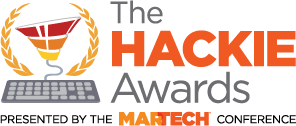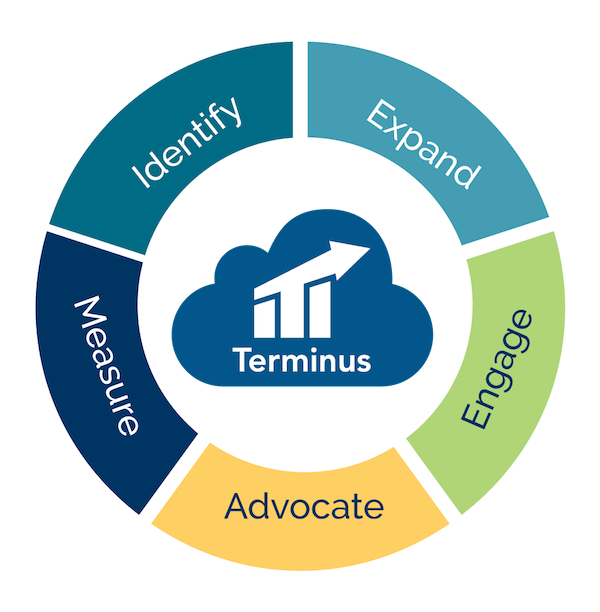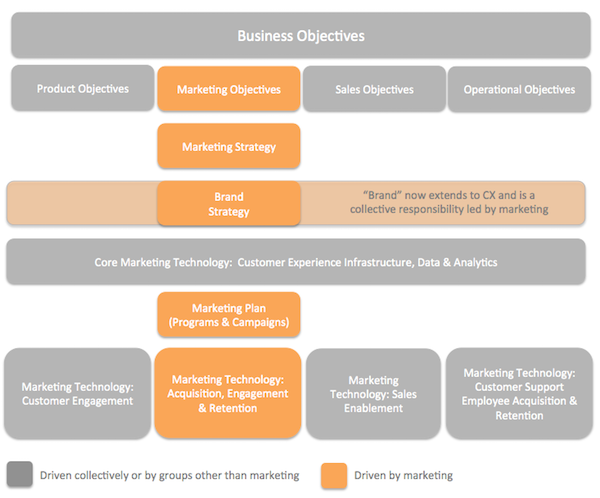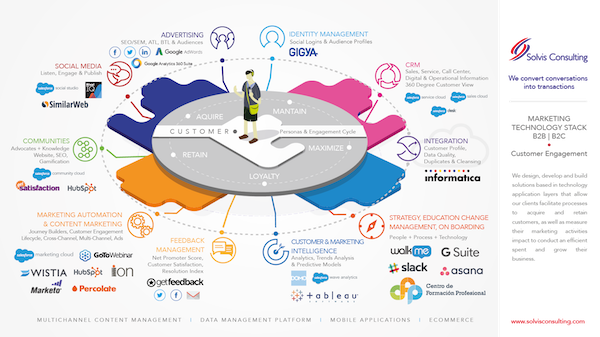This article is a guest post by Sangram Vajre of Terminus. It was entered into The Hackies essay contest for the upcoming MarTech conference. Like it? You can register your vote in the contest by sharing it on social media, especially LinkedIn, Facebook, and Twitter.
Account-based marketing (ABM) at its core is laser-focused B2B marketing. By no longer doing “spray and pray” email blasts to thousands of contacts for lead generation, marketers are adhering to an account-based approach that leverages existing B2B marketing technology.
Think about it: at the core of every best-in-class B2B #MarTech stack are four components:
- Customer relationship management (CRM)
- Marketing automation
- Content management
- Social media
These “backbone” technologies are all focused on one goal: connecting with your customers. Thus with account-based marketing being focused on growing revenue from your best-fit customers (accounts), the technology foundation is set to do scalable ABM.
Now since the rise of account-based marketing, hundreds of B2B software vendors have put a stake in the ground declaring their platforms can do ABM. In one way, they do, because ABM wouldn’t exist in the context it does today without the whole category of marketing technology.
With thousands of vendors in the #MarTech landscape, ABM helps to refine the ways in which B2B marketers use those tech tools to engage prospects, opportunities, and customers. But how?
Account-Based Marketing Technology
I created the #FlipMyFunnel model for account-based marketing in 2015 on my way home from the #MarTech conference in San Francisco, stuck in the middle seat of the airplane between two rather inebriated people (the full story here). I drew the traditional B2B marketing funnel then flipped it upside down to create the “customer experience” tech stack, which evolved into #FlipMyFunnel following this model:
- Identify your best-fit accounts based on your ideal customer profile (ICP) effectively creating a target list of companies for marketing and sales to align around
- Expand the account profiles with company information and contact data for buyer personas, expanding the opportunities to connect with potential new customers
- Engage contacts in those accounts through a variety of tools and technology such as email, direct mail, advertising, social media, events, video, whatever channel is most applicable as long as it’s “on their terms”
- Advocate through word-of-mouth marketing and providing an awesome experience for your customers (whether they’re paying your company or not) to create an authentic voice for your brand
With these four stages of account-based marketing, or a comprehensive B2B customer experience, there are a variety of tools and technology to align at each stage. And with so many vendors claiming they can do ABM, I came up with another idea to help educate B2B marketers on how to actually do ABM.
Building Your Account-Based Marketing Stack
With the existing ecosystem of a CRM, marketing automation, and other tools in the B2B MarTech stack, practitioners needed help with understanding opportunities for improvement. Thinking about maximization, how can martech stacks be “hacked” for ABM programs?
Using the #FlipMyFunnel model as a baseline, Terminus built the Account-Based Marketing Stack Grader. This interactive tool provides a framework for B2B marketers to select software partners who can help progress accounts successfully through each stage of the customer experience.
- Identify: Selecting accounts should be done collaboratively with marketing and sales. Predictive technology can augment a team’s ability to choose the best accounts prioritizing based on fit with current customer base or predicting intent. After selecting a list of accounts, data tools allow you to fill your CRM with contacts and other important data to begin engaging accounts.
- Expand: Tools in the Expand category provide deeper access and coverage within an account in a variety of ways — enriching contact data, providing an account-based structure to leads/contacts, or allowing engagement campaigns to reach more stakeholders. Many tools that expand reach also are used to identify or engage accounts.
- Engage: Marketers must engage individuals within accounts across the entire buyer’s journey. In each sub-category, consider the tools used to execute your account-based marketing strategy and exclude those that are exclusively used for other marketing strategies. Modern ABM tools allow practitioners to engage the right personas at more accounts with personalized and targeted messaging and content.
- Advocate: The relationship with an account doesn’t end after signing the deal. Account-based marketing is the best way to drive adoption, upsell and cross-sell, and referral. For the customer journey, the ABM stack is focused on marketing tools to create new revenue and expand revenue in existing accounts. The tools in this section allow customers to become your best advocates both within their company and across the market.
Now we did add another stage to building your ABM stack: Measure. Insight into the effectiveness of your account-based marketing efforts is critical. These tool help with measuring and reporting ROI, spend, attribution, and impact on revenue. Account-based marketing metrics shoulds alway tie back to revenue and pipeline measures including size, progress rates, and time to close. These tools provide insight and results from an account-based perspective to see what efforts moved the needle by account.
The ABM Stack Grader allows marketers to select from nearly 200 software solutions that support account-based marketing. Each marketer’s stack receives a grade of the sophistication of the entire technology solution, not just the effectiveness of a single tool. These grades include Novice, Intermediate, Advanced, and Expert. Hundreds of B2B marketers have used the ABM Stack Grader to evaluate the effectiveness of their MarTech stacks and operationalize an account-based marketing strategy.
Closing
As David Raab wrote in his inaugural Account Based Marketing Vendor Report, “ABM is a strategy, not a technology. But ABM requires many tools, including data and predictive modeling to identify target accounts; campaign engines to orchestrate messages; execution systems to deliver those messages; and analytical systems to evaluate results… As interest in ABM has exploded in the past two years, the number of vendors offering such tools exploded as well. These vendors offer many different capabilities, adding new confusion to the already perplexing task of assembling an effective marketing stack.”
To know if your marketing stack is effective for ABM, the proof is literally in the pudding: revenue. When the results come in at the quarter, in reviewing targeted account lists and revenue generated within those accounts, the whole company will know if marketing is successful in supporting sales. All the martech in the world can’t build laser focus; only a B2B marketer can.
What did you think of this article as an entry in The Hackies essay contest for the upcoming MarTech conference? If you liked it, you can register your vote in the contest by sharing it on LinkedIn, Facebook, and Twitter.




